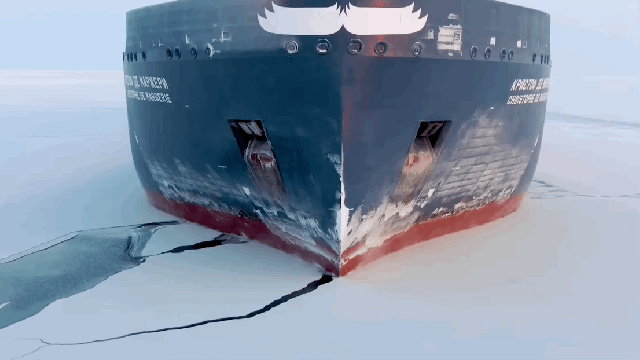Every day, the Arctic slips further into an unstable state. The latest sign: A Russian icebreaker and liquid natural gas ship have traversed the Northern Sea Route in February for the first time due to exceptionally low and weak sea ice cover.
The new Arctic is untethered from the past, and the ship’s trip is a huge red flag for what the future could hold for the region as countries race headlong into the region and plant their flag over the vast resources it holds.
The tanker, Christophe de Margerie, traversed the Arctic via a route that went from a liquid natural gas port on the Yamal Peninsula in western Siberia to Jiangsu, China, the province north of Shanghai. The trip took it across six Arctic seas, four of which it had help navigating with the icebreaker, 50 Let Pobedy. On Feb. 19, both ships safely reached the Sabetta terminal, marking the end of the journey.
Rosatom, a Russian state nuclear energy company that owns the nuclear-powered icebreaker, released a video last week detailing the two ships’ trip across the Arctic set to music that wouldn’t be out of place as a scene in the Avengers where all the superheroes assemble. In a press release from Sovcomflot, the Russian shipping company that owns the gas tanker, issued an equally cheery assessment of the passage.
“As a result of the early Northern Sea Route voyage completed by Christophe de Margerie in May 2020, as well as the current Northern Sea Route voyage, the navigation in the Eastern part of the Arctic was practically doubled,” Igor Tonkovidov, CEO of Sovcomflot, said.
While the Russian companies may be stoked about their changing fortunes, this is bad news for the planet for numerous reasons. The new route across the Arctic is possible because of rapidly rising temperatures. The region the ships traversed has seen its old sea ice dwindle to practically nothing. Older, thick ice tends to be more resilient against hotter ocean and air temperatures. Without it, younger icepack is more prone to break-up and even when intact, tends to be more brittle. The trip across the Arctic is a jarring sign of that new reality.
The loss of ice intensified last year, with sea ice hitting the second-lowest extent ever recorded. The drop in the seas north of Siberia was particularly acute due to the summer heat wave that sent temperatures spiraling above 37.8 degrees Celsius and caused the Yamal Peninsula’s tundra to explode. The warmth also cooked sea ice, and the fact that this winter’s icepack is passable is the end result. Indeed, Siberian icepack failed to reform on schedule last fall.
But this isn’t just a one-off event. Rosatom noted in the video caption that cargo traffic along the Northern Sea Route is expected to increase more than threefold to 80 million tons per year. Meanwhile, Sovcomflot is excited to receive 18 “new-generation” icebreaking liquid natural gas tankers between 2023 and 2025 to service an Arctic gas project capable of producing 20 million tons per year.
Oil and gas companies have been waiting for the opportunity to extract fossil fuels from the Arctic for decades. Climate journalist Amy Westervelt documented in a series of tweets how American companies applied for patents for equipment specially built to access and extract oil and gas from the Arctic as far back as the 1970s, a time when they knew the impacts of climate change but sowed doubt in public on the causes. Drilling in the Arctic has been a business opportunity decades in the making, fuelled by the companies that now stand to profit off it while locking in suffering and misery around the world. A report released last month from the Centre for Climate and Security notes the Russian plan for the Yamal Peninsula and other parts of the Russian Arctic is making it “a zone for gas production and export on par with Qatar and the U.S.,” which would essentially be climate game over.
In addition to the risks to the climate, more Arctic activity also raises the risk of both geopolitical and ecological crises. The Biden administration announced it would treat climate change like a national security issue, and the Arctic could be ground zero in many ways as it’s both the fastest-changing part of the world and the one where countries are already jostling for resources. Russia, Canada, and Denmark have all claimed the North Pole as their own, for example.
Thirteen non-Arctic countries are observers to the Arctic Council, including rising powers like China and India. The interest in the region by both businesses and governments is high, and it’s almost certainly not out of the kindness of their own hearts. The Centre for Climate and Security report from last month found that even if the world keeps warming within the range of the Paris Agreement, that could still “drive broader international security risks with highly uncertain consequences” whether through intentional aggression or misunderstandings as more commercial traffic raises the odds of conflict.
At the same time, more commercial activity also raises the risk of ecological disaster. While the Arctic is more accessible, that doesn’t mean it’s exactly easy to get clean-up crews there should an oil spill or some other kind of accident happen. The BP Deepwater Horizon disaster, a spill that happened in the relatively accessible Gulf of Mexico, is still impacting the region 10 years after the fact. The Arctic is a fragile place with even more to lose should a spill happen there. Even absent a spill, icebreakers could still have a detrimental effect on wildlife in the region.
All this is to say that last week’s successful voyage across the Northern Sea Route is a sign of impending calamity.
